4 Examples of Geotargeting [Updated for 2022]
![4 Examples of Geotargeting [Updated for 2022]](https://retro.nativ3.io/wp-content/uploads/2022/08/locationmarketing-1-1024x576.png)
In 2018, Burger King harnessed the power of geotargeting to accomplish a level of pettiness most of us can only aspire to when dealing with direct competitors.

This location-based marketing tactic, called the Whopper Detour, encouraged hungry customers to park within 600 feet of a Mcdonald’s lot, order a Whopper on the Burger King app, and enjoy lunch for the meager price of a single red cent.
Once the user checks out, the app would then provide turn-by-turn navigation to their nearest BK to pick up their order. For all intents and purposes, the restaurant chain quite literally stole customers. right out from under the Golden Arches.
BK’s ingenious, multifaceted geo-targeting scheme to use location technology to encourage app downloads, increase orders, and draw massive consumer buzz ticked the boxes on all fronts.
Not only did it offer novelty, but it also removed barriers to use with a little help from the location-based services available on all smartphones.
In return, the restaurant saw:
- 1.5 million app downloads and the #1 spot across all categories on both iOS and Android
- 3.5 billion social media impressions
- 37:1 ROI
Burger King isn’t the first company to hop on this bandwagon, and they’re certainly not the last.
As search engine ad management has become more accessible, so too has the ability to target consumers based on their IP addresses or, in the case of mobile phone users, which tower their signal is pinging off of.
Location-based technology is a powerful ally in your fight to gain sales and garner customer attention.
Companies that you interact with every day use geographic locations to finetune their marketing effort and make sales where they matter most– right in our own backyard.
What is Geotargeting?
Geotargeting, often stylized as geo-targeting, uses specific location data to create hyper-relevant marketing messages explicitly designed for local prospects.
The geographic location range can span as far as several countries or as near as a pre-set radius around a brick-and-mortar store.
Types of Geotargeting
Before implementing a geotargeting advertising strategy, take some time to determine the purpose behind your marketing efforts.
Are you trying to attract foot traffic from the weekly farmer’s market that’s happening a block away or remarketing to customers that stopped by your store last week?
Do you want locals to check out your landing pages about your upcoming annual sale or attract high-quality leads that are ready to convert as soon as possible?
Depending on your answer, you’ll want to select the type of geotargeting advertising most conducive to your goals while narrowing in on small, specific customer base segments.
Audience Targeting
Not to be confused with the general concept of creating segmented target lists, audience-based geotargeting campaigns use shopping habits and historical location data to deliver remarketing ads.
Example
After assessing six months of visitor data, Doggie ‘Dos Pet Salon notices that they are most likely to get walk-ins on Saturday afternoons, which often puts the groomers behind schedule.
To encourage customers to book appointments on Fridays or Sundays instead, the business offers a 10% discount to a targeted list of those who show a history of being at the shop’s specific location on Saturdays.

Weather Targeting
Weather targeting creates the opportunity for hyperlocal advertising by using a specific region’s prevailing conditions as a catalyst for marketing efforts.
Example
The GruberGreets food delivery app sends a push notification for free delivery to target consumers who live in a particular region on a cold, gloomy day.
They do so assuming that their target audience prefers to stay indoors, where it’s warm, rather than brave the chill to pick up dinner.
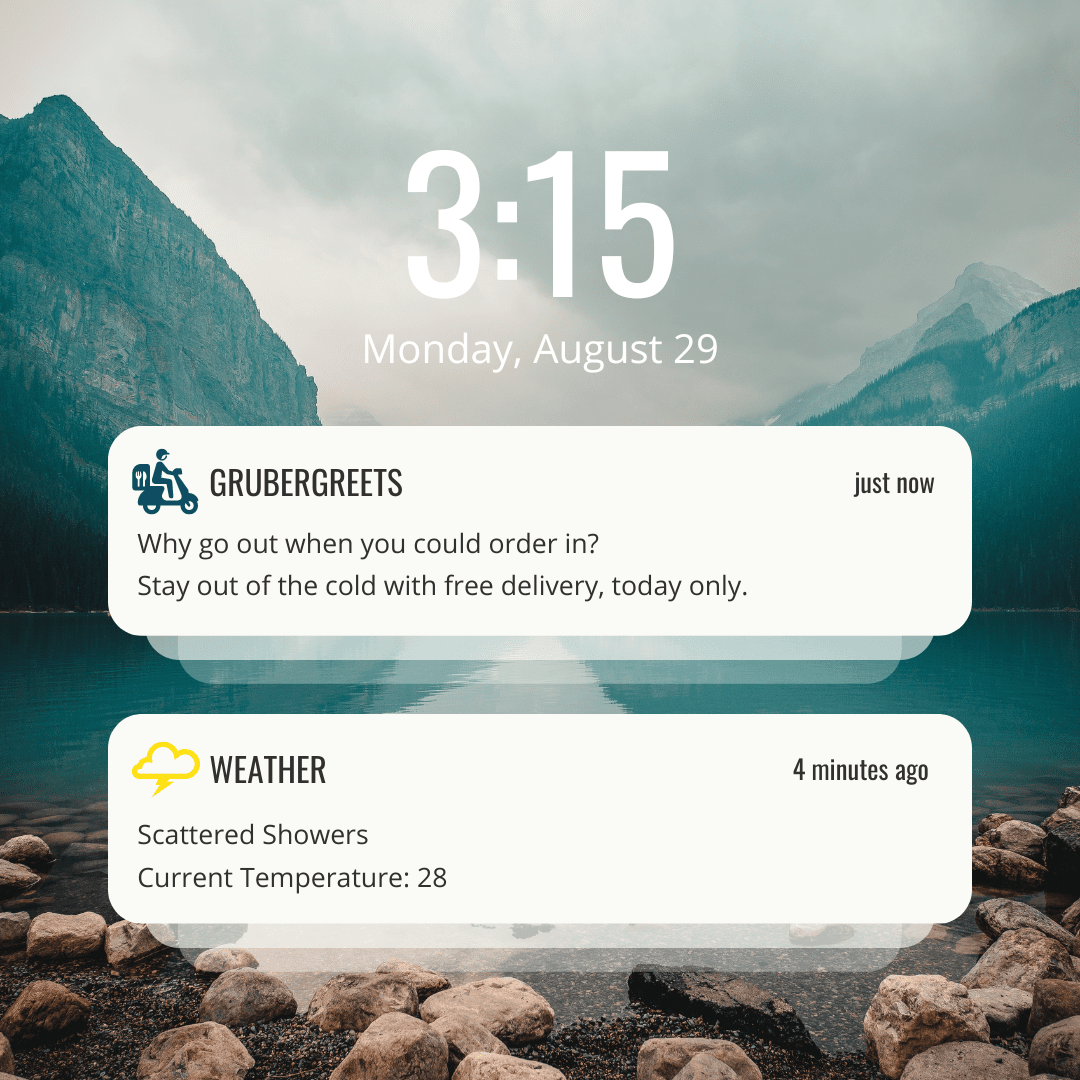
Local Intent Queries
Local SEO is incredibly powerful, especially considering that 46% of all searches have local intent.
To further put its potency into perspective, consider the fact that 72% of people that use local search end up visiting business locations within a 5-mile radius.
The most obvious and often-seen targeted promotions are those that appear when users search with terms like “near me” or “in Minneapolis” included in the query.
Google returns a list of different locations that offer that product or service compiled into a handy list, complete with addresses, phone numbers, and website links.
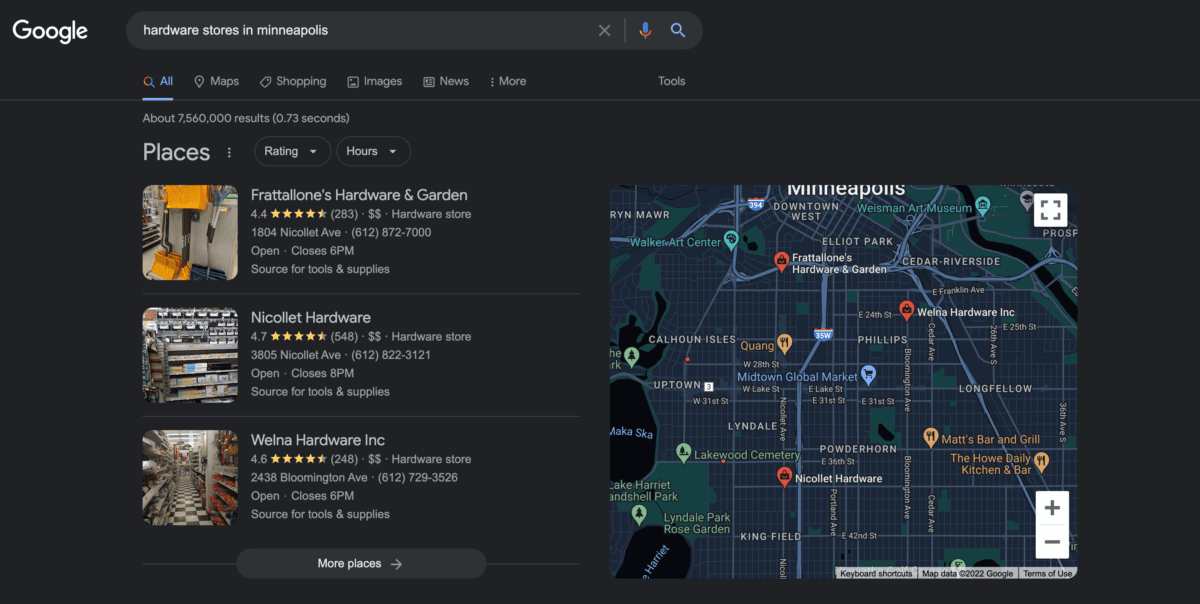
Example
Anna is out running errands and remembers that she still needs to pick up a few pieces of PVC pipe.
She searches for the term “hardware store near me” to determine the options closest to her actual location on Robin Road.
Google returns a list of several locations within 10 miles of her mobile GPS signal, each of which includes the option to open Google Maps for turn-by-turn directions without needing to visit the website or type in the address.

Local PPC
Search advertisers also use radius targeting to market their product or service via the Google Ads PPC geotargeting software.
Before you jump head first into paid geotargeting advertising, ensure you have the patience and budget to conduct A/B testing.
Otherwise, you might find you’re not getting the returns you were hoping for.
These ads perform best when you’ve tweaked your settings appropriately to include hyper-relevant copy and optimized radius targeting.
Example
Sneaker Zone wants to attract back-to-school shoppers by offering a backpack filled with supplies for every $100 spent on shoes.
Using the Google Ads location targeting marketing platform, they build out geo-targeted advertising campaigns that use the same keywords as high-frequency, seasonal queries like “affordable school supplies,” “shoes near me,” “school supplies near me,” “free school supplies,” and “best back-t0-school shoes.”
They set their permanent location targeting filters to include the neighborhoods surrounding the local elementary schools in the tri-county area and their recent location filters for customers that visited other shoe stores or office supply stores in the last three days.

Location-Based Marketing Campaign Strategies
Once you understand how you can leverage the types of geotargeting, you can apply that information to create highly effective campaign strategies.
Location-Based Social Media
Social media geotargeting ads are one of the most valuable tools available for reaching key demographics, especially for local entrepreneurs and small business owners who can’t yet afford a Google Ads budget.
By creating a business profile, listing your products, and providing 5-star worthy service, you’ll find a steep increase in local traffic as users become more comfortable using social media marketplaces and checkout systems
Why?
Social e-commerce revenue is currently valued at $585 billion and takes up a 7% share of all online purchases, with Facebook and Instagram climbing to the top pole positions for preferred platforms.
Furthermore, 72% of online shoppers wish that they had more opportunities to make purchases through social media sites.
Instagram’s location targeting feature uses the same system as Facebook location targeting, so once you’re familiar with creating ads on one of these marketing platforms, you can easily use that knowledge to set up similar campaigns on the other.
Example
612 Redo is a newly-established furniture restoration service that specializes in turning battered but well-made antiques into affordable showcase pieces.
Because of cost-prohibitive shipping costs, all customers must be within driving distance. The owner sets the permanent location for target consumers to within 25 miles and turns off recent location settings altogether.
Beaconing
Beacons rely on Bluetooth technology to deliver targeted ads to app users based on their proximity to a particular product within the building.
Example
A customer shopping in the bread aisle might get a message that there’s a buy-one-get-one-free sale on a particular brand or an invitation to pick up a complimentary half-dozen cupcakes as they walk toward the bakery.
Geofencing
Geofencing falls under the umbrella of geo-targeting but is far less specific in terms of demographics outside of the user’s recent location.
Rather, it draws an invisible “boundary line” around a particular set of broadcast locations. As a customer enters or exits that zone, they receive a notification from your business urging them to stop by or tempting them with a deal that’s too good to pass up.
Example
Larry’s Landscaping business is based out of his home, so he’s been relying on paper flyers and print ads for marketing. His recent bid for the city park maintenance contract was accepted, so he’s interested in using his influx of cash and status to revamp his campaigns.
Larry decides to geofence the park, triggering an automatic SMS to anyone on his business contact list that reads, “Wish your lawn looked this good?” and provides a link to his online booking calendar.
Why Ad Campaigns Based on Geographic Location Matter
Whether you’re a small business owner or a corporate CEO, your marketing campaigns can benefit from analyzing mobile and web IP address data, finding location trends, and creating targeted promotions that appeal to consumers in that area.
Just a few of the benefits include:
Increased Ad Engagement
When customers see personalized, local ads based on the queries they’re already searching for, you’re removing barriers to purchase, like shipping times or fear that they won’t receive a high-quality product.
That results in increased ad engagement, conversion-ready customers, and high-quality leads for your business.
Attracting Foot Traffic
Brick-and-mortar stores aren’t going anywhere anytime soon, but you can use your visitor’s location data to attract customers to your store instead of their online shopping cart.
Creating a More Positive Community Reputation
Investing your ad spend in relevant location groups and geotargeting advertising opens the door for your business to become a trusted, reputable establishment, especially if you encourage your customers to leave reviews online.
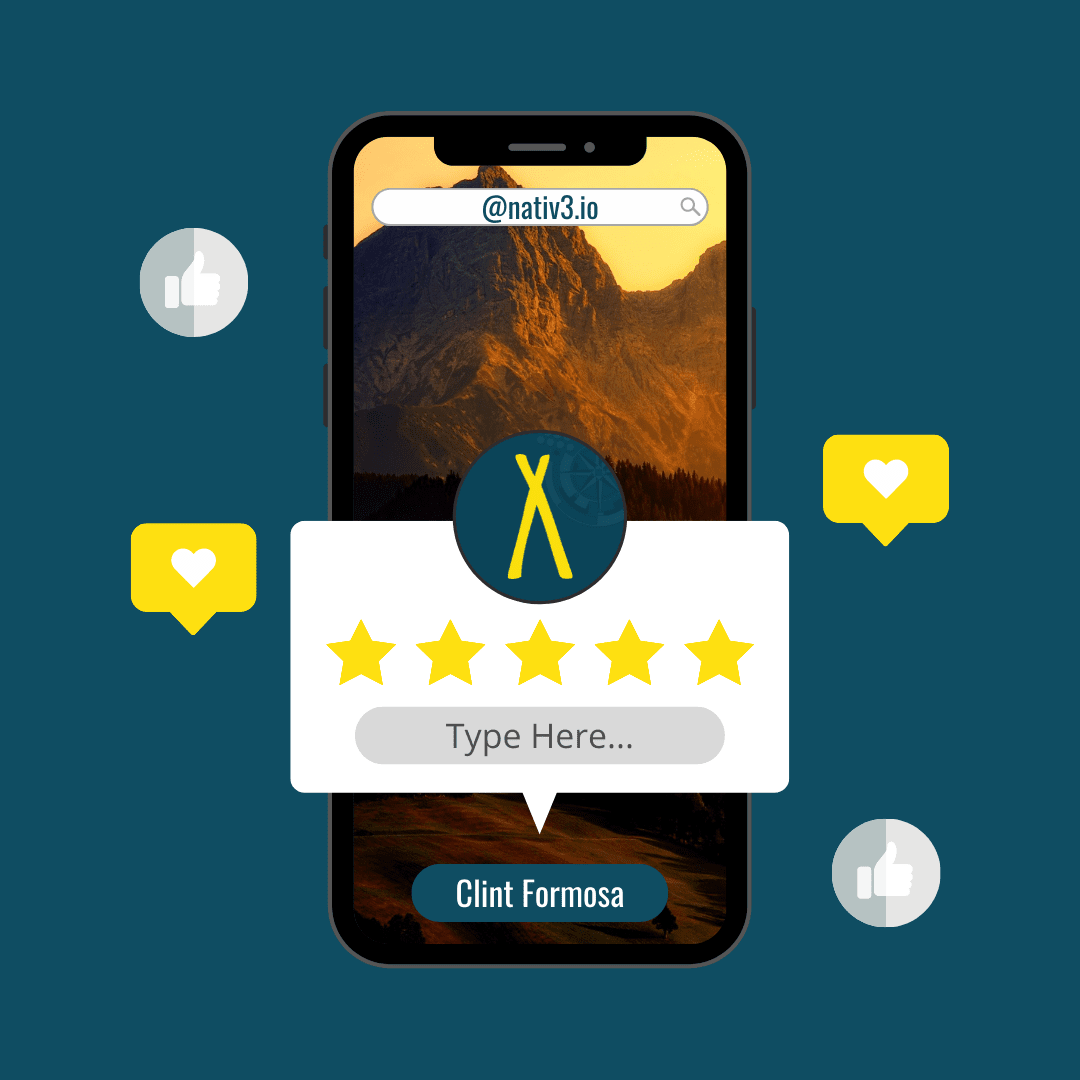
Targeted ads based on permanent locations are an excellent way to draw in long-term customers willing to share their experiences with their friends and neighbors.
Potential Downsides of Geotargeting Marketing Campaigns
Geotargeting helps advertisers create a more immersive and personalized customer experience, but that doesn’t mean it isn’t without its pitfalls.
Before jumping into allocating a huge portion of your advertising budget towards geo-targeting, keep these potential hurdles in mind:
Users Have Concerns Over Privacy
With rising concerns about online privacy and advertisers’ ability to target users based on sensitive data, such as their specific locations, there is an evergrowing sense of distrust amongst consumers.
This has become markedly more obvious lately, exemplified by Google’s scheduled obsoletion of tracking cookies and the implementation of Apple’s App Tracking Transparency requirements.
Opt-In Requirements Can Limit Your Ability to Serve Ads
When Apple released iOS 14.5’s App Tracking Transparency guidelines, which required apps to obtain explicit opt-ins for tracking, many businesses feared that there would be a significant decrease in their ability to geo-target consumers effectively.
Early numbers proved them right, with average rates topping out at 16% in May 2021, but recent data has shown that opt-in rates are at 25% across all app types.
These numbers have consistently risen over the last year, painting an optimistic picture for the future of geotargeting advertising.
VPNs Reroute Location Services
Another barrier to reaching customers within specific regions is the prevalence of VPNs, with 61% of mobile users and 59% of desktop users turning on the service at least once a week.
Because VPNs spoof server locations and mask users’ IP addresses, anyone who has the service turned on won’t receive ads from your geotargeting campaign.
4 Brand Examples of Geo-Targeting Marketing Campaigns
In the above examples, we focused on hypotheticals to help you visualize what more general cases where geotargeting software and advertising campaigns are useful.
Now, let’s explore how four different brands put them in place successfully.
Japanese Retailer PARCO Turns Shopping into a Game
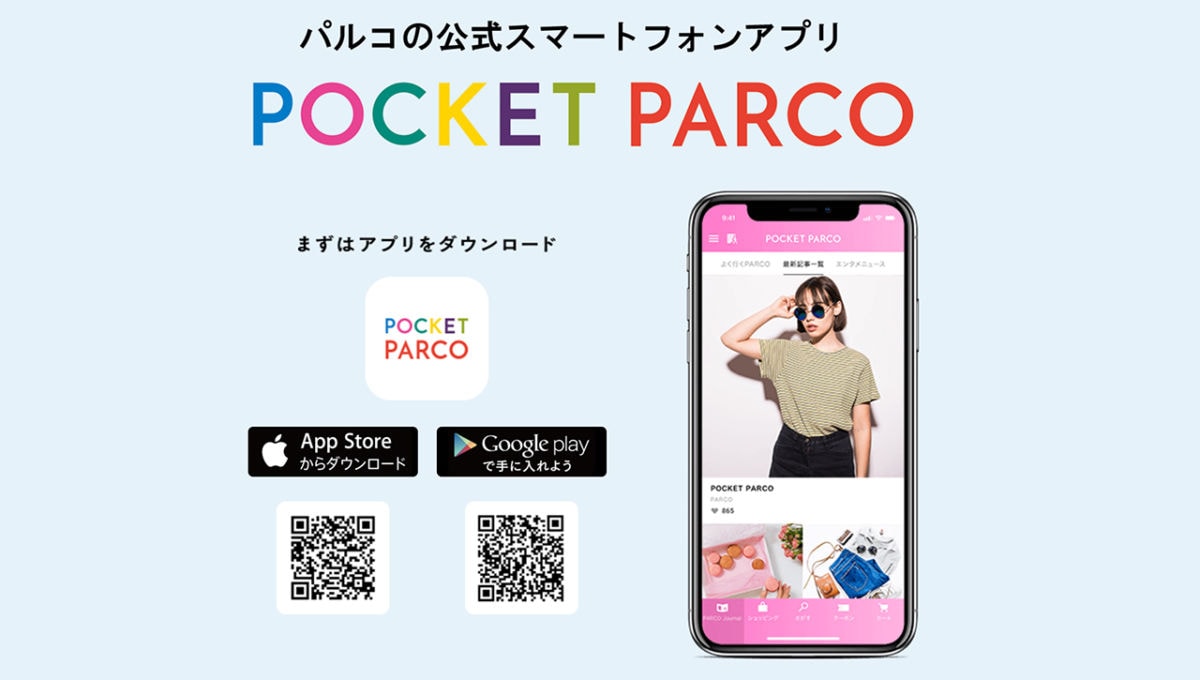
Japanese shopping mall chain PARCO released The POCKET PARCO app in October 2014, with omnichannel location targeting at the heart of the project.
The goal was the augment the customer journey by allowing technology to take on the lion’s share of promoting shops, sales, and customer loyalty rewards, allowing time for more robust in-person interactions.
Geo-Targeting Campaign strategies Highlights and results
- PARCO uses beacon technology and geofencing to deliver sale notifications as shoppers enter specific locations near or within certain stores.
- Weather-based location targeting automatically delivers “rainy day specials” to encourage a more consistent flow of customers regardless of the current conditions.
- PARCO WALKING COIN, an in-store game, rewards users with coins they can exchange for discounts on their purchases. Customers earn the in-app currency based on the number of steps they take as they browse, encouraging shoppers to venture into stores they’d never visited or stop by special events.
- 35% increase in-store visits
- 25% increase in purchase rates attributed specifically to IoT promotions and weather-based location targeting
- 25% of customers make a purchase at a store after receiving their beacon-based sale notification
- 8% increase in repeat visit rate
Urban Outfitters Tailors Ads According to Customer’s Habits and Travel Plans
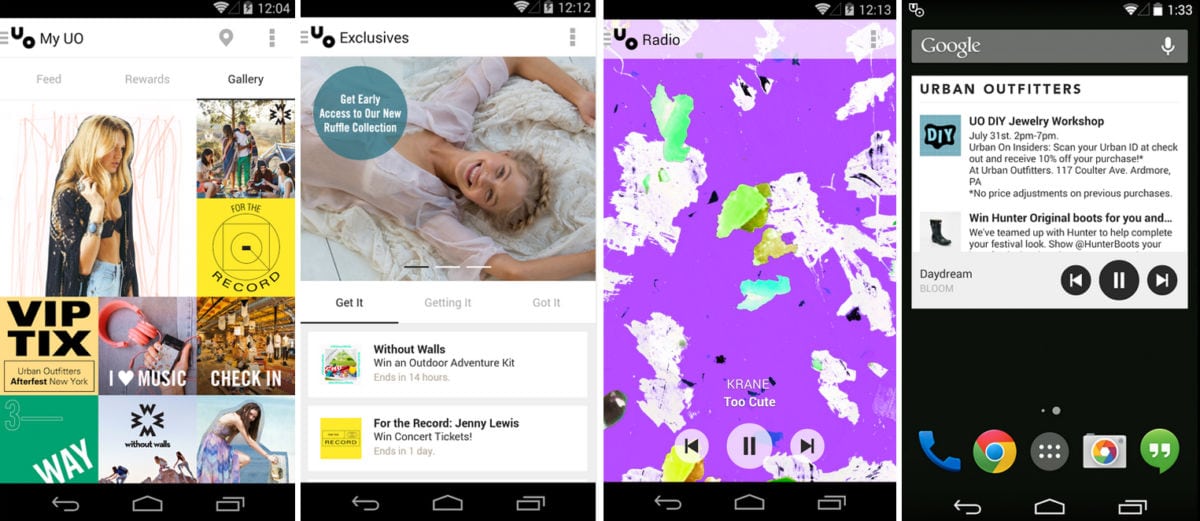
Retail giant Urban Outfitters has long embraced geotargeting marketing campaigns, both at home and abroad, by creating an aggressive strategy centered around mobile ads, app notifications, and email.
Geo-Targeting Campaign strategies Highlights
- Urban Outfitters used geotargeting software to send push notifications about cocktail and party dresses to a very specific market of women who had a location history that included nightclubs.
- After witnessing several English geotargeting ads flopping in Brazil, the US-based clothing retailer changed tactics and delivered ads based on the Portuguese language. In return, they saw a 25% lift over the original marketing campaigns.
- The marketing team combined geo-targeted touchpoints, such as shipping times to certain locations and culturally-relevant blog content, to increase their sales in Australia.
- 146% increase in revenue
- 75% increase in conversions
WeedMaps App Becomes a Different Kind of “Gas Buddy” and Improves
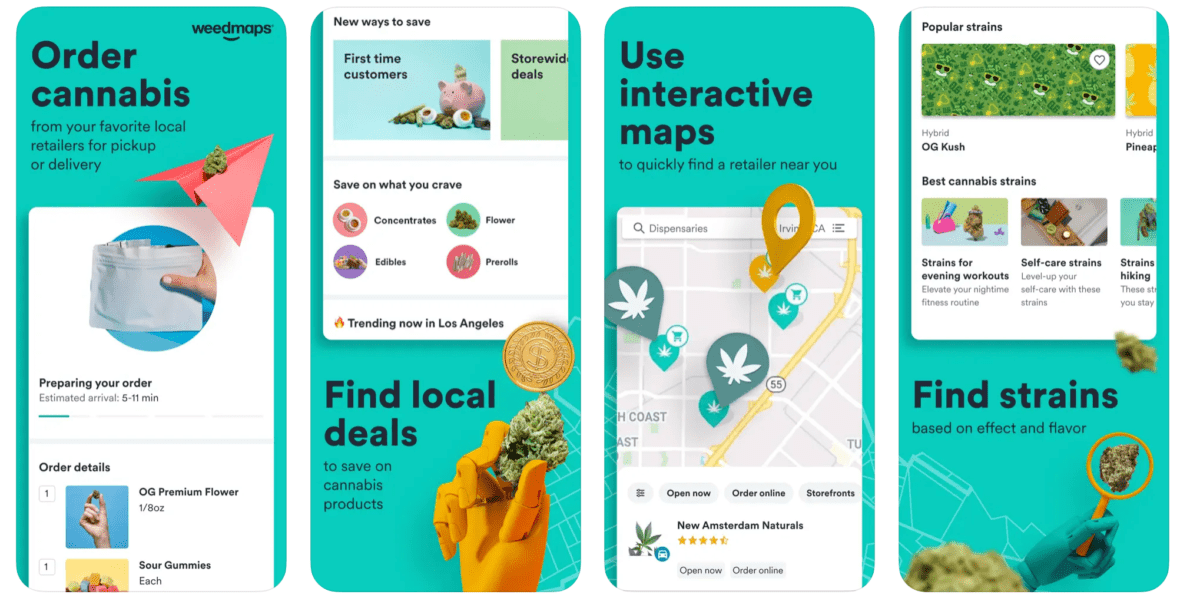
WeedMaps, an app that offers “concierge service” for cannabis, uses location targeting to populate a map of dispensaries within a user-determined range.
Not only can users peruse the store inventory by selecting a shop from the locations drop-down menu, but the app also adds visual elements by encouraging dispensaries to market themselves with high-quality photos of each of their products.
Retailers benefit from having a good advertising platform to showcase their wares and establish themselves as a reputable service, thanks to WeedMap’s built-in omnichannel ad suite, brand-building tools, and reputation management services.
Geo-Targeting Campaign Strategies Highlights
- Radius targeting allows users to find the best deals on their favorite strains in their immediate area.
- A robust search filter lets customers quickly determine if a select location has what they’re searching for.
- Retailers can stay locally relevant by checking out the competition from the user-end interface, monitoring the most popular purchases, and creating geo-targeted PPC advertising without relying on Google Ads.
- 24% year-over-year increase in revenue
- 41% increase in monthly active users and 31% increase in average monthly paying clients from June 2021 to June 2022
- 93% gross profit margin rate
SXSW Delivers a Personalized Experience According to User’s Location within the Festival Grounds
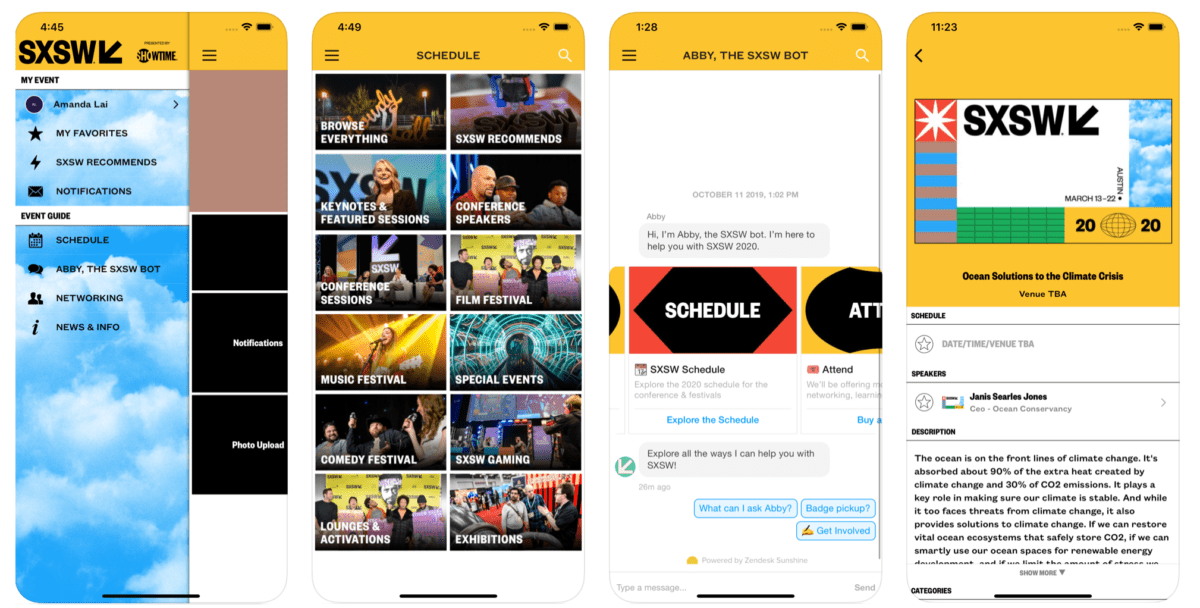
As one of the largest gatherings of innovators, techies, artists, film fanatics, and musicians worldwide, the SXSW Conference and Festival knows that its 417,000 attendees are always watching for what incredible new features organizers will introduce next.
After introducing the Mobile Wallet Pass in 2016, SXSW upped the ante by providing location- and interest-based recommendations, nearby networking opportunities, and information about exhibits as attendees passed by certain areas.
Geo-Targeting Campaign strategies and Highlights
- Beacon data provided valuable information on how long visitors stayed at exhibits, common walking paths, and event attendance.
- The festival encouraged networking by allowing users to easily toggle their location services on or off within the app. When on, other attendees could find folks who shared their interests, had similar exhibits in their schedule, or just wanted to chat via the in-app messaging system.
- As users showed up for their events, location targeting allowed the app to distribute digital credentials, thus reducing printing and supply costs.
Results:
- Reduced credential costs by 54%
- Distributed 25% more event passes
Final Thoughts
As you start to explore the potential of geotargeting, we want to encourage you to start slow and do your research.
Tossing all your eggs in one basket is tempting, especially if you’re dealing with a sustained downward trend in foot traffic and revenue.
Unfortunately, the only way that you’ll harness the full potential of tools like Instagram locations or beacon services is by developing a comprehensive understanding of your target audience, from their buying habits to their search queries.
If you don’t want to go it alone, the NATIV3 team of digital marketers can help you dissect your audience into useful, granular data that allows you to tap into the power of geotargeting.
From there, we’ll build you a highly-targeted digital campaign that meets your future customers where they are, whether it’s right around the block or across the country.